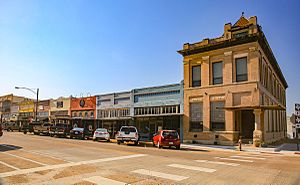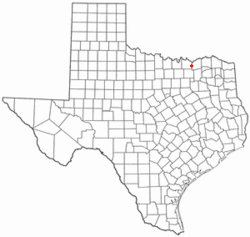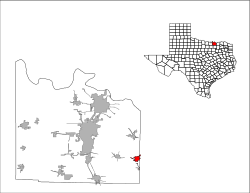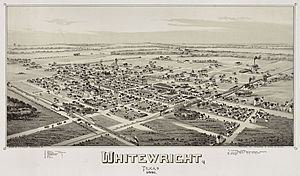Whitewright, Texas facts for kids
Quick facts for kids
Whitewright, Texas
|
|
|---|---|

Downtown Whitewright, Texas
|
|
| Motto(s):
"Warm Hearts. Warm People. Winning Ways."
|
|

Location of Whitewright, Texas
|
|
 |
|
| Country | United States |
| State | Texas |
| Counties | Grayson, Fannin |
| Area | |
| • Total | 1.86 sq mi (4.82 km2) |
| • Land | 1.86 sq mi (4.81 km2) |
| • Water | 0.00 sq mi (0.01 km2) |
| Elevation | 764 ft (233 m) |
| Population
(2020)
|
|
| • Total | 1,725 |
| • Density | 927.4/sq mi (357.9/km2) |
| Time zone | UTC-6 (Central (CST)) |
| • Summer (DST) | UTC-5 (CDT) |
| ZIP code |
75491
|
| Area code(s) | 903, 430 |
| FIPS code | 48-78628 |
| GNIS feature ID | 2413481 |
Whitewright is a small town located in Texas, a state in the United States. It is found in both Fannin and Grayson Counties. In 2020, about 1,725 people lived there. This was a bit more than the 1,604 people counted in 2010.
The part of Whitewright that is in Grayson County is also part of the larger Sherman–Denison area, which is a group of cities and towns connected by their economy.
Contents
History of Whitewright
Whitewright started in 1878. A man named William Whitewright Jr. from New York bought a piece of land. This land was right where the Missouri–Kansas–Texas Railroad was building its tracks. The community was named after him.
Mr. Whitewright had the land measured out for a town. He sent two agents, Jim Reeves and Jim Batsell, to sell plots of land. Because it had a train connection and was in a very rich farming area, many people and businesses soon moved to Whitewright.
Within 10 years, the town had grown a lot. It had its own private school called Grayson College. There was also a public school, a newspaper, and many businesses. These included three hotels, two cotton gins (machines that separate cotton fibers), and two banks. The first post office opened in 1878.
By 1900, the town's population was 1,804. Even though the population went down a little in the next few years, businesses continued to do well. By the mid-1920s, two major railroads, the Missouri-Kansas-Texas and the Cotton Belt, served the town. There were 68 businesses, including two banks and factories that made cottonseed oil and flour. Whitewright was an important center for farmers in the area. They grew crops like cotton, wheat, and corn.
The population grew again from 1936 to the late 1940s. During the 1970s and 1980s, seven factories provided jobs for local people. These factories made things like sausage, clothes, and fertilizers. By 1990, 1,713 people lived in Whitewright. In 2000, there were 1,740 residents and 106 businesses.
The Great Fire of 1911
On June 12, 1911, a big fire started in Whitewright. It began in a pile of trash and strong winds helped it spread quickly. The fire destroyed most of the town's business area. The fire station and city hall were lost, along with 43 businesses. About 75 homes were damaged, and 27 of them were completely destroyed. Firefighters from nearby Denison and Sherman were called to help. Luckily, the fire was brought under control before the Sherman team even arrived.
Valuable Art from Quedlinburg
Whitewright was once connected to a fascinating story about valuable art from Quedlinburg, Germany. After World War II, a U.S. soldier named Joe Tom Meador, who lived in Whitewright, found several important pieces of art in a cave near Quedlinburg Castle.
On April 19, 1945, American troops took control of Quedlinburg. Many art treasures had been hidden in a cave for safety. Meador was in charge of keeping the cave secure. He knew a lot about art and realized how important these treasures were. Among them were ancient books like the Gospel of Samuel and beautiful crystals from Constantinople.
Meador sent these art pieces to Whitewright using army mail. The art was then kept safe in a bank vault. After Meador passed away in 1980, his family tried to sell some of these art pieces. After a long search and legal discussions, the art was returned to Germany in 1992. The pieces were checked for any damage. They were first shown in Munich and Berlin, and then finally returned to Quedlinburg in 1993. However, two of the art pieces that Meador had taken are still in the United States, and their location is unknown.
Geography of Whitewright
Whitewright is mainly in the eastern part of Grayson County. A small part of the town also reaches into Fannin County. U.S. Route 69 goes through the southern and western areas of the town. This road leads northwest about 20 miles to Denison and southeast about 33 miles to Greenville. Texas State Highway 11 also crosses the southern part of Whitewright with U.S. Route 69. It goes southeast about 36 miles to Commerce and northwest about 17 miles to Sherman.
The United States Census Bureau says that Whitewright covers a total area of about 1.86 square miles (4.8 square kilometers). Only a very small part of this area, about 0.004 square miles (0.01 square kilometers), is water.
Population Information
| Historical population | |||
|---|---|---|---|
| Census | Pop. | %± | |
| 1880 | 100 | — | |
| 1890 | 880 | 780.0% | |
| 1900 | 1,804 | 105.0% | |
| 1910 | 1,563 | −13.4% | |
| 1920 | 1,666 | 6.6% | |
| 1930 | 1,480 | −11.2% | |
| 1940 | 1,537 | 3.9% | |
| 1950 | 1,372 | −10.7% | |
| 1960 | 1,315 | −4.2% | |
| 1970 | 1,745 | 32.7% | |
| 1980 | 1,760 | 0.9% | |
| 1990 | 1,713 | −2.7% | |
| 2000 | 1,740 | 1.6% | |
| 2010 | 1,604 | −7.8% | |
| 2020 | 1,725 | 7.5% | |
| U.S. Decennial Census | |||
| Race | Number of People | Percentage of Total |
|---|---|---|
| White (NH) | 1,317 | 76.35% |
| Black or African American (NH) | 133 | 7.71% |
| Native American or Alaska Native (NH) | 12 | 0.7% |
| Asian (NH) | 5 | 0.29% |
| Mixed/Multi-Racial (NH) | 94 | 5.45% |
| Hispanic or Latino | 164 | 9.51% |
| Total | 1,725 |
In 2020, the town of Whitewright had 1,725 people living in 745 households. There were 408 families among these households.
Education in Whitewright
The town of Whitewright is served by the Whitewright Independent School District. Students in the area attend schools within this district. The local high school is Whitewright High School, and their sports teams are known as the Whitewright Tigers.
Notable People from Whitewright
- Benny Binion, a casino owner in Las Vegas
- Julie Johnson, an actress
- Kay Kimbell, a generous person who helped create the Kimbell Art Museum
- Tyrone Swoopes, a talented athlete who played for the University of Texas
- George Washington Truett, a well-known Southern Baptist religious leader
- Guy Wilkerson, an actor
See also
 In Spanish: Whitewright (Texas) para niños
In Spanish: Whitewright (Texas) para niños


